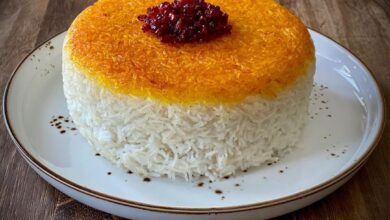Delicious Saffron Steamed Rice – Authentic Persian Recipe (Serves 4)
In Persian cuisine, saffron steamed rice is not just a side dish—it’s an art form. Known for its delicate aroma, fluffy texture, and signature golden hue, this type of rice is often served at Persian feasts, weddings, and celebrations. Using a traditional draining method followed by steaming, the result is perfectly separated, fluffy basmati grains infused with the magical taste of saffron. If you’ve ever enjoyed Persian food at a restaurant and marveled at the rice, chances are it was saffron steamed rice prepared this way.
This recipe will guide you step-by-step to make authentic saffron steamed rice at home. Whether you’re a seasoned cook or a beginner, you’ll be able to follow the method and impress everyone at the table

Table of Contents
ToggleIngredients (Serves 4)
| Ingredient | Quantity |
|---|---|
| Basmati rice | 2 cups |
| Salt | 2 tablespoons |
| Brewed saffron | 2 tablespoons |
| Vegetable oil | 2–3 tablespoons |
| Water | As needed |
📌 Use high-quality long-grain basmati rice for the best saffron steamed rice results.
Step-by-Step Instructions
Step 1: Wash and Soak the Rice
Start by cleaning the rice. Rinse 2 cups of basmati rice in cold water several times until the water runs clear. This step is crucial for removing excess starch, which helps keep the grains separate during cooking. Add 1 tablespoon of salt and soak the rice for 2 hours.
🔸 Tip: If you’re short on time or a beginner, you can skip the soaking—but soaking ensures fluffier rice.
Step 2: Boil Water for Parboiling
In a large, deep pot, add enough water to fill it halfway. Place it on high heat and bring it to a rolling boil. Once the water is boiling, add 1 tablespoon of salt. Drain the soaked rice and get ready to parboil.
Step 3: Parboil the Rice
Add the drained rice into the boiling water. Stir gently once to prevent sticking. Let the rice cook for 8 to 10 minutes. To check if it’s ready, pinch a grain between your fingers—it should be soft on the outside but firm inside.
✅ The rice should not be fully cooked—it will finish cooking during the steaming phase.
Step 4: Drain and Rinse the Rice
Pour the rice into a colander immediately and rinse under cold water to stop the cooking process. This also removes extra starch, which is key for getting that classic saffron steamed rice texture.
Shake the colander lightly to help the steam escape and prevent the grains from clumping together.
Step 5: Prepare the Pot with Saffron and Oil
Return the pot to the stove on low heat. Add 2–3 tablespoons of vegetable oil and 2 tablespoons of brewed saffron. Swirl the pot so that the base is coated.
🟡 This saffron-oil mixture will give your saffron steamed rice its vibrant golden crust and beautiful aroma.
Step 6: Steam the Saffron Steamed Rice
Add the rice back into the pot using a spoon or ladle. Layer it gently, never dump it all at once. Use the back of the spoon to create a small well in the center of the rice to help steam circulate evenly.
Cover the pot with a clean kitchen towel and a tight-fitting lid. Use a heat diffuser if available. Steam the rice over medium heat for 10 minutes, then reduce to very low and cook for another 40–45 minutes.
⏱️ This slow steaming process is what makes saffron steamed rice so fluffy and aromatic.
Step 7: Mold and Serve
After steaming, turn off the heat. Gently loosen the edges with a spatula. If you want a molded shape, place a serving dish over the pot and flip it upside down. Otherwise, fluff the rice with a fork and serve.
Garnish with more saffron water or toasted nuts for a luxurious finish.

Pro Tips for Perfect Saffron Steamed Rice
Use aged basmati rice for the best results.
Never stir the rice after layering in the pot.
The steam hole helps keep the rice fluffy.
Don’t skip rinsing—excess starch is the enemy of fluffy rice.
How to Add Tahdig
Tahdig is the golden crispy bottom layer of rice. For a potato or bread tahdig:
Place thin potato slices or lavash bread over the saffron-oil mixture in the pot.
Proceed with layering the rice as above.
Steam as directed. Once done, carefully loosen and flip to reveal the crispy bottom.
🍽️ Tahdig is considered a delicacy in Persian cuisine and adds amazing texture to saffron steamed rice.
FAQ
Can I use jasmine rice instead of basmati?
Basmati rice is highly recommended for saffron steamed rice due to its long grains and aromatic profile. Jasmine rice tends to be stickier and won’t yield the same results.
What’s the best way to brew saffron?
Grind saffron threads with a pinch of sugar, then dissolve in hot (not boiling) water. Let it steep for at least 10 minutes.
Can I make saffron steamed rice in advance?
Yes, you can refrigerate it for up to 4 days. Reheat by steaming again with a splash of water to restore texture and aroma.



